





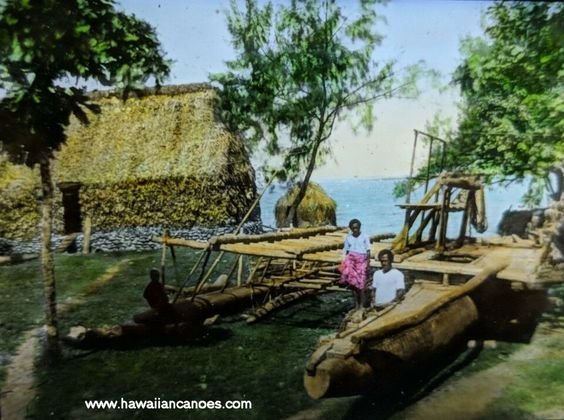

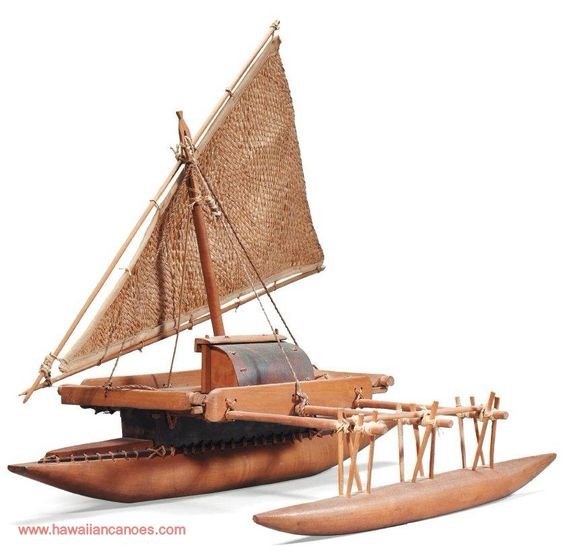





















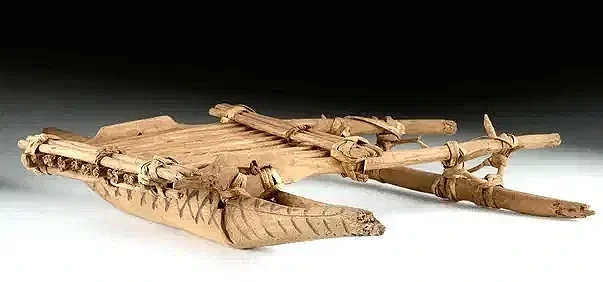

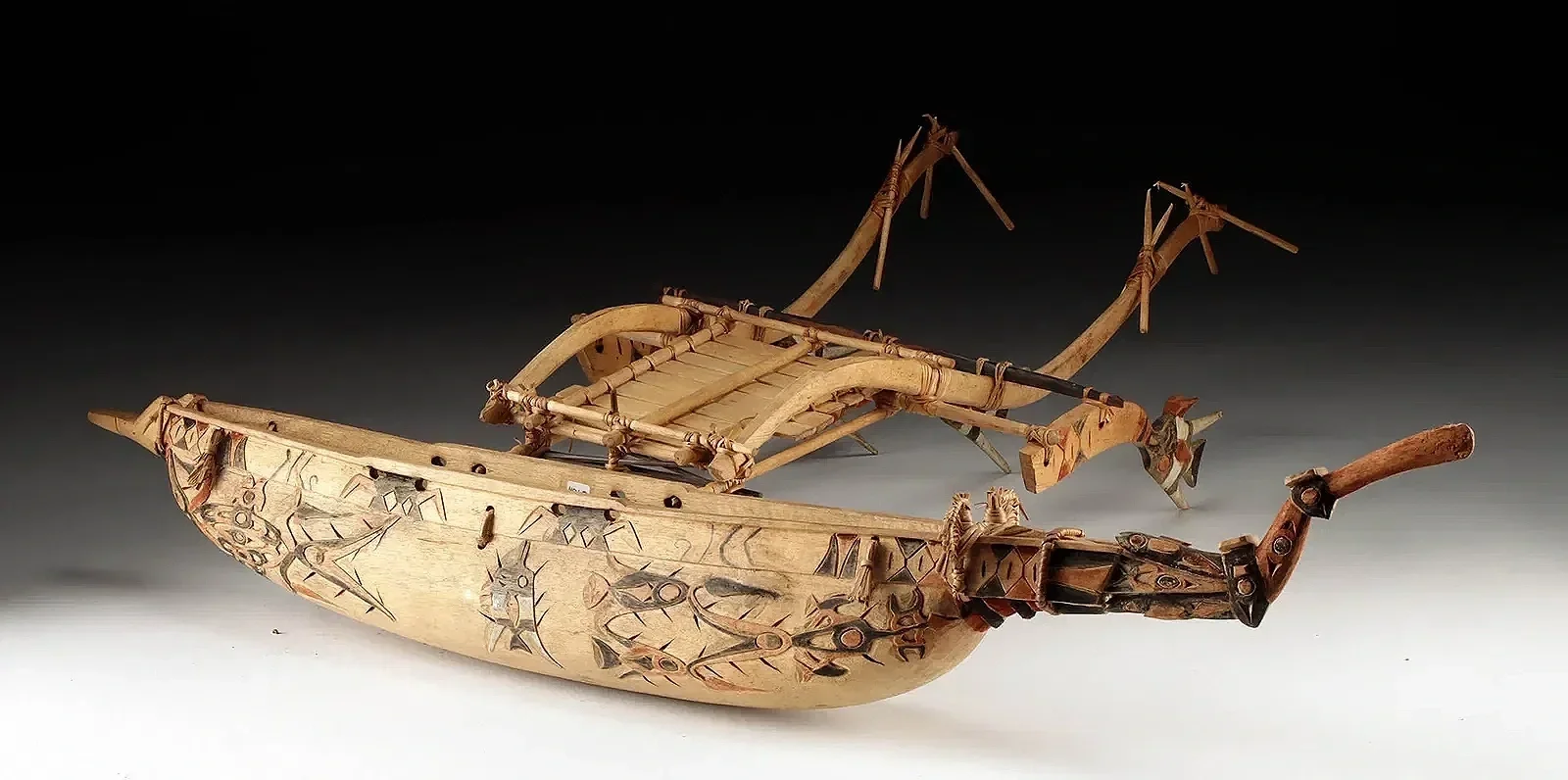




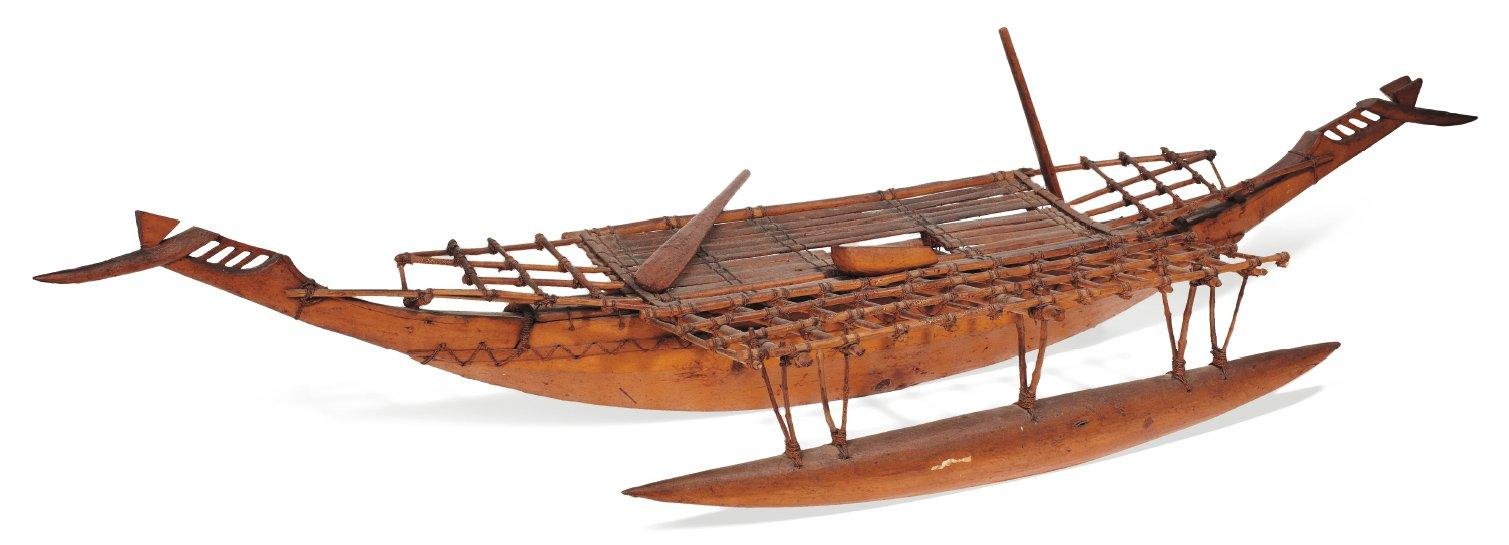

















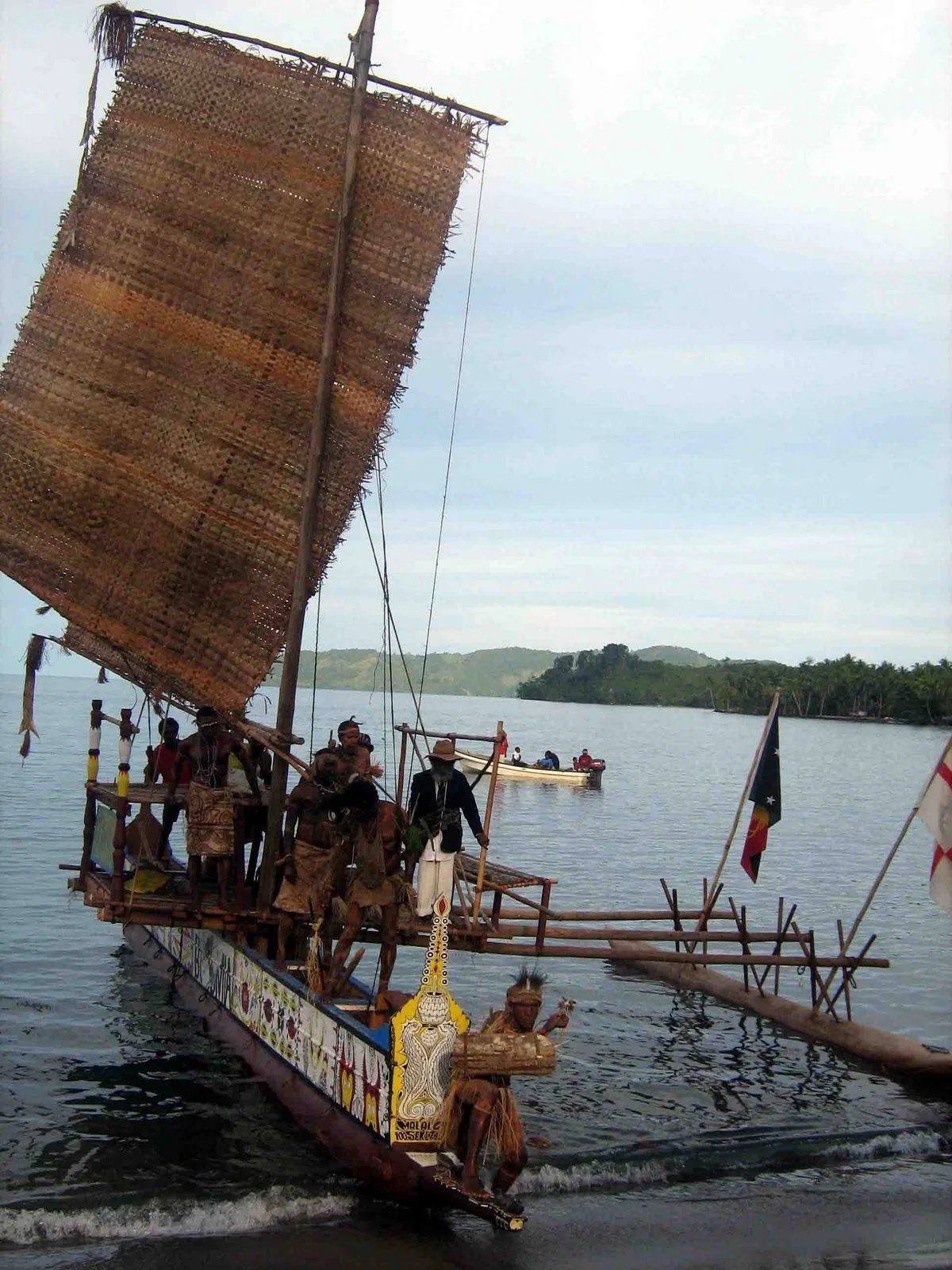

Taiwan
Looks very much like a Solomon island canoe, but no, it is a “Tatala” canoe from Taiwan…The history of Polynesia does go through Taiwan.
FIJI
One look at the mast head and it is definiyely a Fijian sailing canoe of the type Thamakau or Kamakao. The topmast or " ndomondomo" end is in a typical two-horned "truck”
PAPUA-NEW GUINEA-
A voyaging canoe model from the Ninigo Islands, which are a group of 31 islands within the Western Islands of the Bismarck Archipelago, Papua New Guinea.
Fiji Drua
A scale model I built several years ago, commissioned by a collector in Taiwan who visited the Fiji Museum in Suva.
Fiji Drua
This is a beautiful and helpful line drawing of a Fiji Drua illustrated in the book VOYAGERS by Herb Kawainui Kane.
FIJI
A small but very old Fijian Drua model
Fiji Drua
A very rare magic lantern slide showing a Fiji drua near a beach in Fiji
FijiOMCmap.png
FIJI PROA
The float connected to the outriggers by three pairs of stanchions would indicate that the canoe is from Fiji. The difference between a Fiji Proa (Kamakau) and a Fiji Drua is that the Drua consists of 2 hulls, whereas a Proa is a single-hull canoe with outriggers and float.
NEW HEBRIDES - VANUATU
Photo postcard 1920. The islands were named “New Hebrides” by Captain Cook in 1774, after the Hebrides in Scotland.
Fiji Drua
This is the last surviving original drua canoe on display at the Fiji Museum., Suva . Suva is the capital of the South Pacific island nation of Fiji.
VANUATU MAP
FIJI
A canoe of the type “Takia” which is the traditional Fijian outrigger canoe
FIJI
A small incomplete model canoe. of the type Takia. The railings would indicate it to be Fijian.
FIJI
The three booms connected to the float with the reverse V arrangement of the pair of stanchions would indicate it to be a thamakau canoe, and not any Samoan type canoe.
FIJI
Fiji camakau racing or “Veitau Waqa” A Veitau Waqa is an annual event in Fiji that celebrates traditional Fijian boat building and sailing skills, particularly of the camakau (a type of outrigger canoe). The event, organized by the Pacific Blue Foundation, aims to revive and preserve this fading cultural heritage through races, demonstrations, and other activities.
Fiji Camakau
Fiji voyaging canoe of the type “vakau” displayed in the Fiji Museum, Suva. This type canoe was very common on the island of Lau and built to be used on the high sea.
FIJI
Fijian Camakau voyaging canoe of the type “Vakau” at the Auckland Memorial Museum. This type canoe was prevalent on the province of Tailevu.
FIJI
Fiji fishing canoe of the type camakau
FIJI CAMAKAU
This is the Fiji voyaging canoe in the “Fiji House” at the Polynesian Cultural Center, Lai’e, Oahu, Hawaii. The canoe is an old, original vessel of which I made a model of it, right down to scale, some years ago.
Fiji Drua
Fiji Drua acquired by the Stiftung Humbold Forum at Berliner Schloss. Note the drums or “lali” at the foot of the canoe.
FIJI
One of the ways to find out whether a canoe is of a Fiji type, is to look no further than the masthead, the “ndomondomo,” which looks like a tow-horned spear. But a masthead of the same shape was also seen on some Tonga voyaging canoes.
Fiji
1920s Photo postcard . Small camakau fishing canoe
FiJI DRUA
The life-size drua on display at the Fiji Museum in Suvais a remarkable example of the most significant and finest sea-going vessel ever designed and built by the indigenous peoples of Oceania prior to European contact. Its construction features an entirely plank-built design, distinguishing it from outrigger boats.
FIJI - CAMAKAU
Line drawing of a Fijian Camakau or Tamatau.
FIJI DRUA
A famous painting by Herb Kawainui Kane illustrating a Drua sailing on the high seas.
FIJI
1930s postcard. Fijian fisherman and turtles.
FIJI DRUA
The Sema Makawa canoe at the New Zealand Maritime Museum.
New Guinea
A fishing canoe model with its “PIU” prow replicating those found in the Humboldt Bay, Papua New-Guinea. Hamilton College (Ruth and Elmer Wellin Museum of Art)
Map of Papua and Papua New-Guinea
Papua-New-Guinea
Humboldt Bay sailing canoe model . This type canoe is described in Hadden in page 314
Humboldt Bay canoe.jpg
PAPUA NEW-GUINEA
Beautiful model of a painted Humboldt Bay area canoe.
FIJI
A beautiful and well made Fiji double canoe model or “wangga ndrua” in the Otago Museum, New-Zealand.
NEW-GUINEA
Large double outrigger Geelvink Bay canoe model. Geelvink Bay is now called the Cenderawasih Bay. This type canoe was mostly built on Japen island.
FIJI
This picture was taken By F.H. Dufty of NAVUKINIVANUA - “The turner of the land” - one of the last of the great drua or hulled-outrigger voyaging canoes of the nineteenth century, and the last to be owned by Ratu Seru Cakobau, anchored just off Nasova on the eastern shore of Ovalau. Given the prestige and the ceremonial dress of the many high chiefs visible in this picture, the occasion is probably that of 20 November 1877, when Navukinivanua was sailed from Bau to Nasova and symbolically presented by Cakobau, together with a big rootstock of yaqona, to Lady Gordon.
In this picture the kata or hull of the canoe is towards the camera, with the smaller outrigger hull or cama masked by it. The mualevu, or “big prow” is to the right, the mualailai or “little prow” to the left. The coconut leaf matting sunshades which were usually rolled down in port are still rolled up, giving a fine view into the deckhouse, which is open to the kata side, the kata allways being kept to leeward in sailing. The mast or vana has been hauled upright from the raking position it is held in when sailing, and the sail and yards rolled and laid along the deck platform, forming a comfortable seat for Ratu Epeli Nailatikau, eldest son of Ratu Cakobau, who is wearing a white iwabale shoulder sash and has his right leg cocked over a coil of heavy vau bark rope towards the left hand duruduru or pilaster of the deckhouse, with lesser chiefs left of him. A group of chiefs wearing white barkcloth ivauvau hair-wrappers are seated on deck before the deckhouse, the bearded old man to the right of the mast being one of Cakobau’s brothers, Cakobau himself is the old man with the resplendent side whiskers (such as he favoured in 1876-77) wearing a shirt and a smoked masikuvui hair-wrapper, who is sitting just to the right of the lali slit drum that is positioned across the right hand outside end of the deckhouse. Several men stand posing on the prow, pretending to pole the canoe along. [Fergus Clunie, 14/7/2003, from record P.27781.VH, JD 7/1/2012]
Papua New-Guinea
A nice model of a Huon Gulf canoe. This type of canoe is considered one of the most beautiful in Melanesia, known for its excellent nautical qualities. Some of these canoes were up to 60 feet long. On the islands of Tami and Siassi, they were called "wang," but nowadays, we mostly refer to them as "Siassi" canoes.
PAPUA-NEW -GUINEA
The Takuu canoes are very similar to those from the islands of Leuaniua and Nuku-manu; however, their canoe prows are more elaborate than those of the latter ones
PAPUA NEW-GUINEA
Outrigger canoe of Luf island, within the Hermit Islands, at the Humboldt Forum, at the Staatliche Museen zu Berlin.
Outrigger boat of Luf Island
This outrigger boat originates from Luf Island, which today belongs to Papua New Guinea. In 1881, the trading company Hernsheim & Co built a trading station on the island. The population resisted. At the instigation of Hernsheim, in 1882/83 soldiers of the Imperial German Navy attacked the island with a “punishment detachment”, destroying a large number of buildings and boats, killing inhabitants and plundering the villages. The building of this big outrigger boat began eight years after this attack. It is said that the men in it wanted to bury their recently deceased leader Labenan at sea. However, this didn’t happen because there were too few of them to get the enormous boat onto the water. Through diseases that were introduced and the consequences of the military attack, the population decreased dramatically. For the next few years, it remained in the boathouse, deprived of its purpose. In 1903, it was acquired by Max Thiel von Hernsheim & Co and sold to the Ethnological Museum in Berlin. The circumstances of the acquisition of the boat on Luf are not documented. The building and acquisition of the boat are the subject of a media station in the “Oceania – people and the sea” room. Interviews of the film maker Martin Maden from Papua New Guinea with Luf inhabitants on the island are also shown here.
The Hermit Islands are a small group of islands in the Bismarck Sea, including Jalun, Maron, and Luf
https://en.wikipedia.org/wiki/Hermit_Islands
The second canoe is that picture is Samoan and there seems to be one from Tuvalu, both Polynesian.
Karta_PG_Bismarck_Archipelago.png
PAPUA NEW-GUINEA
VIEW OF MURRAY’S ISLANDS , WITH THE NATIVES OFFERING TO BARTER 1814. An engraving by John Pye and W. Finden
This richly decorated canoe, originating in the Torres Strait was mostly adopted by the islanders of Mawata and Kiwai . This type voyaging canoe, but also used for spear fishing,
was named “gul” or “nar” on some Torres Islands, or “motomoto” and “ burai” in the region of Mawata.
SANTA CRUZ ARCHIPELAGO- DUFF ISLAND
Taumako canoe mode of the type Tepuke
PAPUA NEW-GUINEA
A Massim model of a Kula outrigger canoe.
A Kula canoe is a large, ceremonial sea-going canoe from the Massim region of Papua New Guinea that is used in the Kula Ring, a complex inter-island ceremonial exchange system. These canoes, called “Masawa”, are intricately decorated by men, and used to transport Kula valuable like necklaces and armbands , as well as for secondary trade goods like food and pottery
Kula canoes were made on several islands in Papua New Guinea, particularly the Trobriand Islands, which were a major center for their manufacture and decoration. Other islands involved in the Kula ring, such as Muyua (Woodlark) Island and Fergusson Island, also contributed to the production of canoes
Trobriand Islands: These islands are frequently cited as a primary source of finely decorated Kula canoes, with master carvers creating elaborate splashboards for ceremonial voyages
Muyua (Woodlark) Island: This island was another significant production center for the ornate splashboards used on the canoes, notes Bowers Museum.
Fergusson Island: An example of Kula canoes being made on this island was documented by Travel Obscure.
Iwa Island: The Oceanic Art Society mentions a specific type of canoe, the "tadobu," that was built on islands such as Iwa Island.
BISMARCK ARCHIPELAGO
Outrigger canoe model, Wuvulu island.
Canoes from Wuvulu and its neighboring island of Aua are called wa. Featuring outriggers, a sleek, pointed profile, and equally pointed vertical spurs on both their prow and stern, there are no canoes quite like them anywhere in Oceania.
PAPUA NEW-GUINEA
A Humboldt Bay canoe model at the Vatican.
SALOMON ISLANDS
“Qua” type canoe, Santa Isabel island.
PAPUA-NEW-GUINEA
TE PUKE type canoe , Duff Island
PAPUA NEW-GUINEA
A “vanagi” , small indigenous canoe from the region of Port Moresby, recognizable by its 3 pairs of outrigger beams .
FIJI
A Camakau canioe, Fiji.
818b7c235d995b916f9a24c3f7c5a7f1.jpg
Kasali-Traditional Salamaua Sail Canoe-Morobe Province